14版人教六年级上册英语教案(1-6单元完整版)
2014新版PEP小学六年级上册unit1-6教案
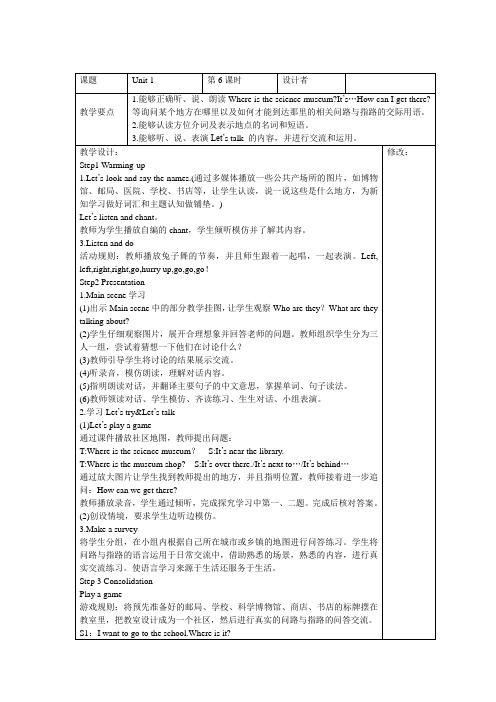
(3)教师引导学生将讨论的结果展示交流。
(4)听录音,模仿朗读,理解对话内容。
(5)指明朗读对话,并翻译主要句子的中文意思,掌握单词、句子读法。
(6)教师领读对话、学生模仿、齐读练习、生生对话、小组表演。
教学设计:
Step1 Warming-up
1.Let’s look and say the names.(通过多媒体播放一些公共产场所的图片,如博物馆、邮局、医院、学校、书店等,让学生认读,说一说这些是什么地方,为新知学习做好词汇和主题认知做铺垫。)
Let’s listen and chant。
教师为学生播放自编的chant,学生倾听模仿并了解其内容。
3.Listen and do
活动规则:教师播放兔子舞的节奏,并且师生跟着一起唱,一起表演。Left, left,right,right,go,hurry up,go,go,go!
Step2 Presentation
1.Main scene学习
(1)出示Main scene中的部分教学挂图,让学生观察Who are they?What are they talking about?
3.Make a new dialogue according to this lesson and act it out.结合本课学习内容创建一个新对话并将其表演出来。
修改:
教后反思:
通过放大图片让学生找到教师提出的地方,并且指明位置,教师接着进一步追问:How can we get there?
教师播放录音,学生通过倾听,完成探究学习中第一、二题。完成后核对答案。
人教版六年级上册英语Unit1《HowDoYouGoThere》教案三篇
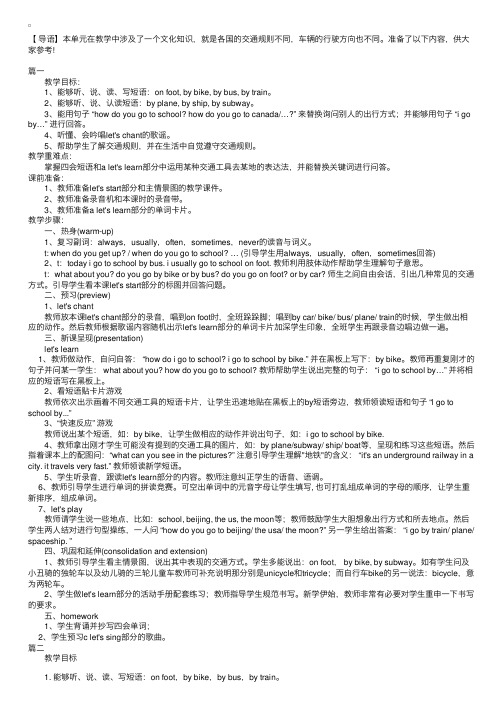
【导语】本单元在教学中涉及了⼀个⽂化知识,就是各国的交通规则不同,车辆的⾏驶⽅向也不同。
准备了以下内容,供⼤家参考!篇⼀ 教学⽬标: 1、能够听、说、读、写短语:on foot, by bike, by bus, by train。
2、能够听、说、认读短语:by plane, by ship, by subway。
3、能⽤句⼦ “how do you go to school? how do you go to canada/…?” 来替换询问别⼈的出⾏⽅式;并能够⽤句⼦ “i go by…” 进⾏回答。
4、听懂、会吟唱let's chant的歌谣。
5、帮助学⽣了解交通规则,并在⽣活中⾃觉遵守交通规则。
教学重难点: 掌握四会短语和a let's learn部分中运⽤某种交通⼯具去某地的表达法,并能替换关键词进⾏问答。
课前准备: 1、教师准备let's start部分和主情景图的教学课件。
2、教师准备录⾳机和本课时的录⾳带。
3、教师准备a let's learn部分的单词卡⽚。
教学步骤: ⼀、热⾝(warm-up) 1、复习副词:always,usually,often,sometimes,never的读⾳与词义。
t: when do you get up? / when do you go to school? … (引导学⽣⽤always,usually,often,sometimes回答) 2、t:today i go to school by bus. i usually go to school on foot. 教师利⽤肢体动作帮助学⽣理解句⼦意思。
t:what about you? do you go by bike or by bus? do you go on foot? or by car? 师⽣之间⾃由会话,引出⼏种常见的交通⽅式。
2014新版PEP小学六年级上册英语教案(分页)
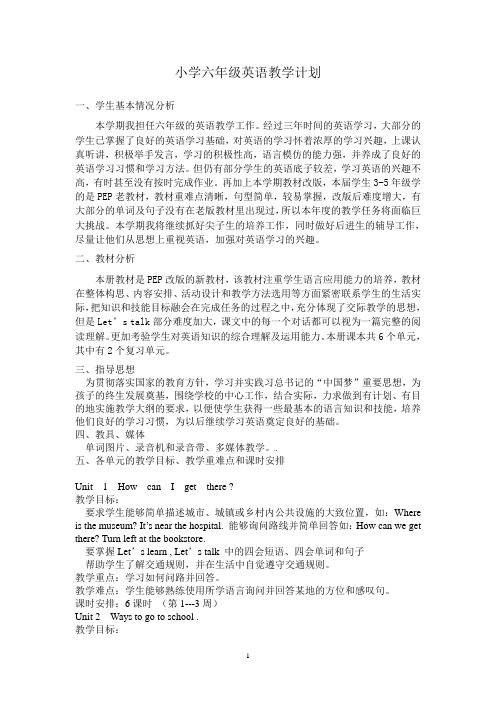
小学六年级英语教学计划一、学生基本情况分析本学期我担任六年级的英语教学工作。
经过三年时间的英语学习,大部分的学生已掌握了良好的英语学习基础,对英语的学习怀着浓厚的学习兴趣,上课认真听讲,积极举手发言,学习的积极性高,语言模仿的能力强,并养成了良好的英语学习习惯和学习方法。
但仍有部分学生的英语底子较差,学习英语的兴趣不高,有时甚至没有按时完成作业。
再加上本学期教材改版,本届学生3-5年级学的是PEP老教材,教材重难点清晰,句型简单,较易掌握,改版后难度增大,有大部分的单词及句子没有在老版教材里出现过,所以本年度的教学任务将面临巨大挑战。
本学期我将继续抓好尖子生的培养工作,同时做好后进生的辅导工作,尽量让他们从思想上重视英语,加强对英语学习的兴趣。
二、教材分析本册教材是PEP改版的新教材,该教材注重学生语言应用能力的培养,教材在整体构思、内容安排、活动设计和教学方法选用等方面紧密联系学生的生活实际,把知识和技能目标融会在完成任务的过程之中,充分体现了交际教学的思想,但是Let’s talk部分难度加大,课文中的每一个对话都可以视为一篇完整的阅读理解。
更加考验学生对英语知识的综合理解及运用能力。
本册课本共6个单元,其中有2个复习单元。
三、指导思想为贯彻落实国家的教育方针,学习并实践习总书记的“中国梦”重要思想,为孩子的终生发展奠基,围绕学校的中心工作,结合实际,力求做到有计划、有目的地实施教学大纲的要求,以便使学生获得一些最基本的语言知识和技能,培养他们良好的学习习惯,为以后继续学习英语奠定良好的基础。
四、教具、媒体单词图片、录音机和录音带、多媒体教学。
.五、各单元的教学目标、教学重难点和课时安排Unit 1 How can I get there ?教学目标:要求学生能够简单描述城市、城镇或乡村内公共设施的大致位置,如:Where is the museum? It’s near the hospital. 能够询问路线并简单回答如:How can we get there? Turn left at the bookstore.要掌握Let’s learn , Let’s talk 中的四会短语、四会单词和句子帮助学生了解交通规则,并在生活中自觉遵守交通规则。
2014年新人教版pep六年级上册英语 unit1 教案设计 1-6课时

3. 教师利用Be a tour guide的插图,组织学生根据地图指路。出发地和目的地可以任选。
1.今天学习了哪些短语?
2.今天需要掌握哪些句型?
1.学生看图学习短语。
2.在游戏中反复操练所学的新词组。
2.通过where canIgo的情景设计,反复操练新单词。
(1)I want to post the letter. Where can I go? (post office)
(2)Oh, I feel bad, I need to see a doctor. Where can I go? (hospital)
2.能够通读文段,获取主旨大意,通过相关细节猜测词义。
过程与方法
小组合作学习, 情景教学法
教学重点
能够正确使用上述句型描述城市设施及其位置
教学难点
能够听、说、读、写句型:Where is the…?It’s near the…How can we get there/ get to the…?Turn left / right at the…
夷陵区小学六年级英语学科课时教学计划
授课时间:9月 日总第1课时
课 题
Unit1 How canIget there
教学内容
Let’s learn
教学领域
New words
第1课时
执教教师
教学目标
情感态度价值 观
能够在迷路时主动寻求帮助。
知识与技能
1.能够听、说、读、写单词和词组:science museum, post office, bookstore, cinema, hospital, crossing, turn left, turn right, go straight,并能在上下文中理解意义。
六年级上册英语教案-Unit 1 How can I get there?B let's learn人教版PEP(2014秋)

六年级英语(上)第1单元第4课时Unit 1 How can I get there?B Let’s learn一、【教材分析】二、【教学流程】A. Turn right.B. Turn left.师教读提示字母组合T:Terrific!T :(PPT 呈现一左转的标志图)Look, this is the sign--Turn left. What aboutthis one? PPT 呈现右转的标志图。
Let ’s listen.T: 师提示igh 的发音,并联系light/night/fight 以旧引新, 让学生当小老师进行教读,拍手齐读,带动作读。
3. 呈现单词go straight.(PPT 呈现go straight 图标)T :If you see this sign , can you turn left?Can you turn right?T: What should we do? Yes! We should go straight.师讲解aigh/tr 发音,边做动作边教读。
4. 呈现单词crossing.T :(出示本课图片)We can see the three signs underthe traffic lights. Look at the boys, where are theynow? They are at the crossing.师教读crossing.Weknow from the crossing ,they should turn left and then they will get to theItalian resturant.6. Listen and imitate.Please pay attention to your pronunciation and intonation.7. Read in groups. And you can help each other.Ⅲ.巩固操练 1. Read by themselves.2. Listen and do. 师示范发指令,全班做动作。
最新人教版六年级英语上册教案(全册 共63页)
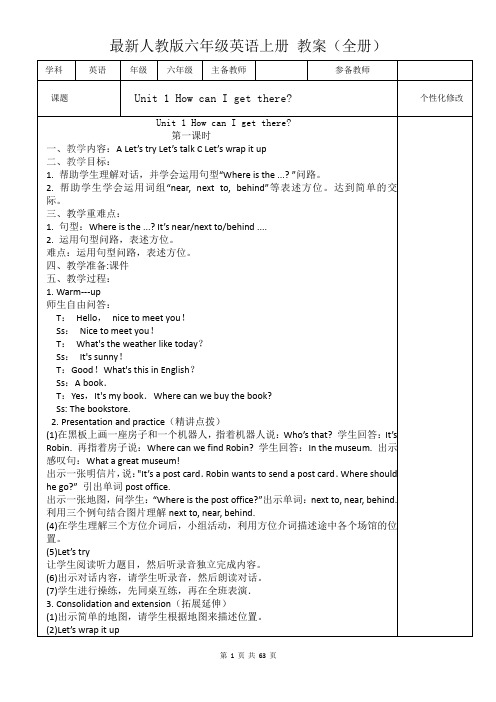
五、板书设计
Unit 1 How can I get there?
How can I get to the ...?
Turn ... at the …Then turn ... at the…
S1: I can see a hospital aቤተ መጻሕፍቲ ባይዱd a post office.
S2: I can see a hospital ,a post office and a cinema.
四、新课呈现(presentation)
1.教学词组:turn left turn right
(1)学生跳“兔子舞”。跳的时候教师要注意示范left和right,如左右脚、左右手的动作。
六、反思
Unit 1 How can I get there?
第四课时
一、教学内容:B Let's learn Be a tour guide
二、教学目标:
1.能听说,读,写单词和词组:crossing, turn left, go straight, turn right.
2.能听说,读,写单词:Italian, restaurant.
(2)朗读课文对话,分角色完成对话。或小组内朗读表演对话。
3. Consolidation and extension(拓展延伸)
(1)出示地图,请小组内完成对话。
How can I get to the ...?
Turn ... at the .... Then turn ... at the...
人教版新起点小学六年级英语上册1-6单元设计教案
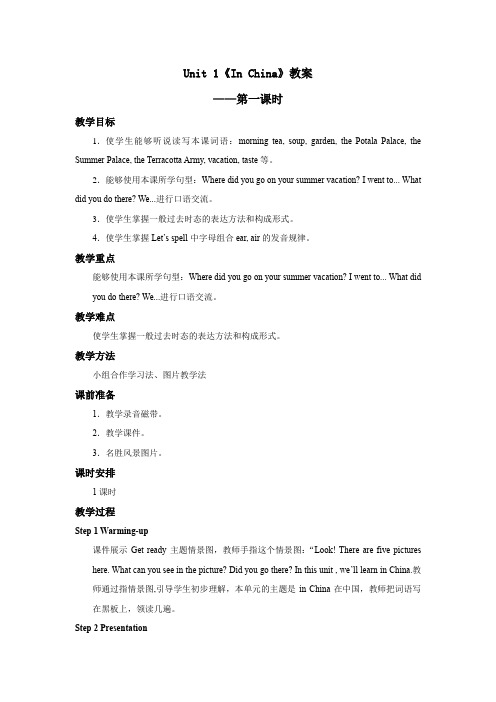
Unit 1《In China》教案——第一课时教学目标1.使学生能够听说读写本课词语:morning tea, soup, garden, the Potala Palace, the Summer Palace, the Terracotta Army, vacation, taste等。
2.能够使用本课所学句型:Where did you go on your summer vacation? I went to... What did you do there? We...进行口语交流。
3.使学生掌握一般过去时态的表达方法和构成形式。
4.使学生掌握Let’s spell中字母组合ear, air的发音规律。
教学重点能够使用本课所学句型:Where did you go on your summer vacation? I went to... What did you do there? We...进行口语交流。
教学难点使学生掌握一般过去时态的表达方法和构成形式。
教学方法小组合作学习法、图片教学法课前准备1.教学录音磁带。
2.教学课件。
3.名胜风景图片。
课时安排1课时教学过程Step 1 Warming-up课件展示Get ready主题情景图,教师手指这个情景图:“Look! There are five pictures here. What can you see in the picture? Did you go there? In this unit , we’ll learn in China.教师通过指情景图,引导学生初步理解,本单元的主题是in China在中国,教师把词语写在黑板上,领读几遍。
Step 2 Presentation1.展示各种风景图片,师:Guangzhou morning tea soup广州早茶。
Lhasa the Potala Palace布达拉宫。
新人教版六年级英语上册全英文教案(全册全英文)

新⼈教版六年级英语上册全英⽂教案(全册全英⽂)新⼈教版六年级英语上册全英⽂教案(全册)Unit 1 How do you go there?Period OneTeaching contents: Part A let’s learn & let’s playTeaching aims:1.To enable the students to master the four skills phrases: on foot,by bike,by bus,by train, by plane,by ship,by subway2.To enable the students to ask about the ways of traffic with the following sentence patterns: How do you go to school? Or How do you go to Canada…?”And answer with“I go by…”Teaching focus:To master the four skills phrases: by train, by plane, by subway, by ship, by bike, on footTeaching difficulty:To differ “subway” from“train”Teaching methods:Communicative ApproachTeaching aids:1.Word cards2.Tape recorder and tape3.Multi-media playerTeaching procedure:1. (Warm-up)Greeting: Good morning , class !Glad to meet you again. How are you?What day is it? What ‘s the date?What’s the weather like today?2. PresentationShow a picture of busT: What’s this? S: It’s a bus.T: I go to school by bus. How do you go to school?(Show a picture of bike and help a student to answer with “I go to school by bike.”) (In the same ways)Teach “by subway” and “by train” “by ship” “by plane” “on foot”.Subway: It's an underground railway in a city.It travels very fast.We can seesubway in Hong Kong, Beijing, Shanghai, Gongzhou…Explain the differences between subway and trainPay attention to the pre. “ by”& “on”3.Play gamesAsk one S to the front and stick the word cards next to the phrases written on the Bb when T read the new phrases quickly and the other Ss put up their cards. The one who reflect fastest and correctly is the winner.4.Listen to the tape of Part A Let’s learn and follow it.Pay attention to the tone and pronunciation5.Practice: Let’s playT Offer many places (the USA. England Australia Hong Kong Shanghai Guangzhou the moon…) and traffic ways (by car/ taxi/ bus… on foot)Ss practice with above places and ways in pairs:A: How do you go to school?B: I go to school on foot.Encourage the Ss to make up as many sentences as they can.6.Spelling competitionDivide the class into tow groups. Show the pictures of traffic tools and ask Ss to spell the phrases. The first one who puts up hand gets the chance to spell. The group spell out more phrases are the winners.HomeworkCopy the new words and phrasesFinish Page1 of the ABBb design:Unit One How do you go there?How do you go to school/ Canada?I go to school on foot/ by subway/ bus/ train/ taxi…Teaching reflection:Unit1 How do you go there? Period TwoTeaching contents: Let’s try & let’s talkTeaching aims:1.To master the four skills sentence: “How do you go to school? Usually I go toschool on foot.Sometimes I go by bike.”2.To enable the Ss to ask and answer about traffic ways and explain the simple reasonwhy he or she chose this traffic way.I go to school on foot, because my home is near.3.To make the Ss understand the listening material in “Let’s try” 情感⽬的Teaching focus:⽂中的新句⼦To use and write the following key sentences:How do you go to school?Usually I go to school by bike. Sometimes I go on foot.Teaching difficult points:To write the key sentences: How do you go to school?Usually I go to school on foot.Sometimes I go by bike.To use Adverbs of frequency: usually, sometimesTeaching aids:Tape recorder Teaching cards a piece of paperTeaching procedure:1. (Warm-up)T: Good morning! How do you go to school today? What about you? Do you go by bus,too?”2. Have a dictationAsk the Ss to dictate the new words learnt in the last lesson.On foot、by bus、by train、by plane、by subway…3. Let'stryGuide the Ss to look at the pictures and askWho’s the boy? He’s Mike. How does Mike go to school?Play the tape and listen:John:How do you go to school,Mike?Mike:I usually go to school by bike.Sometimes I go 0n foot.John:Is your home near our school?Mike:Yes.it is.J0hn:That's fine!4. (Presentation)Let's talkT: How do I go to school,do you know? Ask me,please!Draw a bike, a bus, a taxi on the Bb and write the price by each picture. Bus 1 yuan taxi 10 yuanEncourage the Ss to ask “How do you go to school?T: Usually I go to school by bike, because it's good exercise.Sometimes I go by bus,because it's cheap.It costs l yuan. Sometimes I go by taxi,because it's fast,butit's too expensive.It costs 1o yuan.Explain that we use usually and sometimes to express frequency.T: “How does Sarah go to school? Listen.”Ask the S to imitate Sarah’s tone to answerSarah: Usually I to go school on foot. Sometimes I go bike.Ss read after the tape. Then practice in pairs to make up the new dialogueaccording to each picture.Ask several pairs to act out the dialogue.5. Group workRead the dialogue .Then practice in groups of four. They can expand their dialogue like the following:A:How do you go to school/ hometown?B:Usually I go by bus.A:Can you go by bike?B: Yes,I can,but it's too far.Sometimes I go by taxi,because it’s fast, but it's expensive. What about you? A:I go to school on foot,because my home is near.6. Play finding order gamesShow the following word cards and ask Ss to form correct sentences.How, do, go, to, school, youI, usually, on, go, school, to, footSometimes, by, bike, go, IHomework:Finish AB Page2Bb designUnit1 How do you go there How do you go to school?Usually I go to school on foot, because it’s near.Sometimes I go by bike, because it’s fast.Period Three Teaching contents: Let’s readTeaching aims:1.To improve reading skill2.To consolidate the traffic ways3.To improve understanding ability.Teaching focus:How do we go to the park?It’s easy.How to finish answering the questions in the bookTeaching difficult points:How to express the different ways to a placeTeaching aids:Tape recorder a piece of paper masks of Zhang Peng and SarahTeaching procedure:1.ReviewFree talk2.Dictation 复习上节课学过的句⼦和词语How do you go to school?Usually I go to school on foot.Sometimes I go by bike. What about you?3.Review different placesT: This is a very nice place. There are many students and teachers. There are many rooms, such as classroom, art room, music room… What’s it?It’s a beautiful place. Many people like to play in it. There are nice flowers, trees and grass. There are toys. What is it?It’s a park.4.PresentationT: Where is my home? Do you want to know?Describe with different traffic ways and use “first” “next” “then” .It’s a little far from here. First I go to Zenbu bus stop on foot. Then I can go by the No.74 bus to the East Bus Station... We live on the ninth floor,Room902.Explain “then”5.T ask individual :Where is your home?Is it near the park? Which floor?In pairs practice above questions6.Play the tape and students follow it.Ask: How can we go to Sarah’s home?How can they go to the park?Finish answering the questions, and then check the answers.7.PracticeRead the text. Boys to be Zhang Peng ,and girls to be Sarah. 男⼥分组朗读Work in pairs to read the dialogue.Ask several pairs to act out.8.Make up new dialoguesHomework:Do Page 5 in ABMake a survey and fill in the following formBb design:How do we go to the park?It’s easy.Which floor?The fifth floor, Room 5APeriod FourTeaching contents: Let’s learn and let’s playTeaching aims:1. To master the phrases: Stop at a red light. Wait at a yellow light. Go at a green light.2. To know some traffic rules about traffic lightsTeaching focus:To understand the traffic lights commands and do the action:Stop at a red light.Wait at a yellow light.Go at a green light.Teaching difficult points:To understand the meaning of the three traffic lights and do the correct action ofthe commandsTeaching aids:Tape recorderA flash card of traffic lightsWord cards。
人教版小学英语六年级上册教案 全册
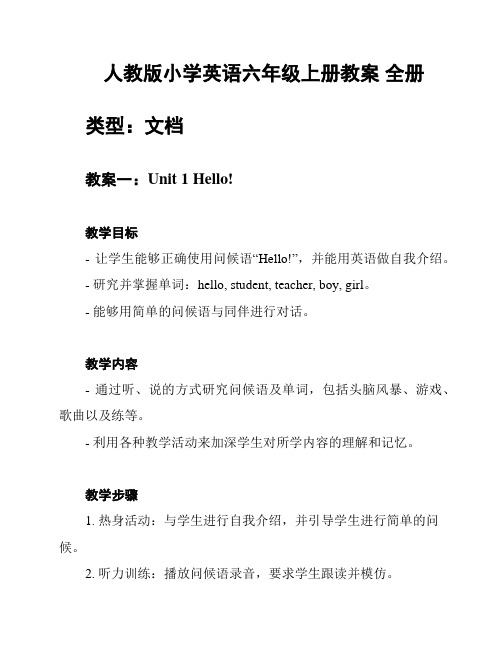
人教版小学英语六年级上册教案全册类型:文档教案一:Unit 1 Hello!教学目标- 让学生能够正确使用问候语“Hello!”,并能用英语做自我介绍。
- 研究并掌握单词:hello, student, teacher, boy, girl。
- 能够用简单的问候语与同伴进行对话。
教学内容- 通过听、说的方式研究问候语及单词,包括头脑风暴、游戏、歌曲以及练等。
- 利用各种教学活动来加深学生对所学内容的理解和记忆。
教学步骤1. 热身活动:与学生进行自我介绍,并引导学生进行简单的问候。
2. 听力训练:播放问候语录音,要求学生跟读并模仿。
3. 单词研究:通过图片和动作来教授新的单词。
4. 对话练:将学生分成小组,进行对话练,鼓励他们运用所学内容进行自由表达。
5. 游戏活动:利用游戏巩固所学内容,例如:跳格子游戏,问题答案接龙等。
6. 歌曲研究:引导学生学唱和表演相关的英文歌曲,如《Hello Song》。
7. 拓展练:分组进行情景对话练,以及针对学生个体巩固练。
8. 总结复:回顾学生所学内容,进行小结和复。
教学评估- 观察学生课堂表现,评价学生是否能正确使用问候语并进行简单的对话。
- 分发简单的练题,测试学生对所学内容的掌握程度。
教学资源- 课件:包括单词图片、歌曲演示、练题等。
- 多媒体设备:用于播放音频和展示课件。
- 学生练册:用于课后巩固和作业。
教案二:Unit 2 How Are You?教学目标- 研究问候语“How are you?”以及常见的回答,并能用英语进行简单的交流。
- 掌握单词:good, fine, great, not bad, ok。
- 能够与同伴进行问候和交流。
教学内容- 通过听、说、读的方式研究问候语及常用表达,包括小组活动、角色扮演、阅读和写作等。
- 利用多种教学资源和活动提高学生的研究兴趣和参与度。
教学步骤1. 热身活动:复上节课所学内容,与学生进行简单的问候。
2. 听力训练:播放录音,让学生跟读并模仿,练问候和回答。
2014-2015学年pep六年级上册英语教案全册
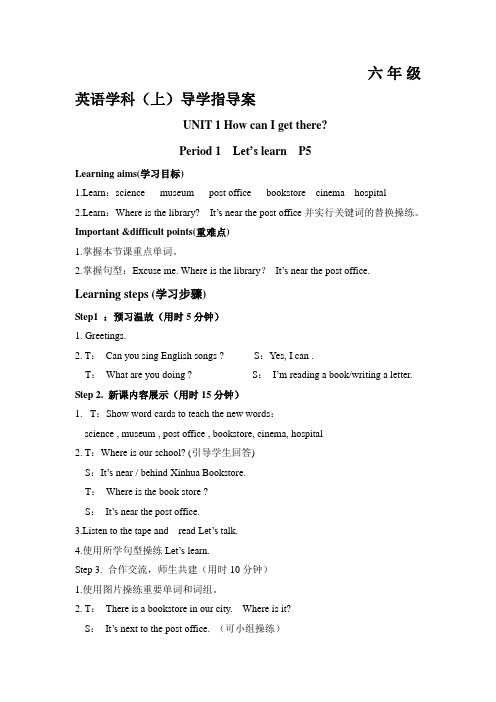
六年级英语学科(上)导学指导案UNIT 1 How can I get there?Period 1 Let’s learn P5Learning aims(学习目标)1.Learn:science museum post office bookstore cinema hospital2.Learn:Where is the library? It’s near the post office并实行关键词的替换操练。
Important &difficult points(重难点)1.掌握本节课重点单词。
2.掌握句型:Excuse me. Where is the library?It’s near the post office. Learning steps (学习步骤)Step1 :预习温故(用时5分钟)1. Greetings.2. T:Can you sing English songs ? S:Yes, I can .T:What are you doing ? S:I’m reading a book/writing a letter. Step 2. 新课内容展示(用时15分钟)1.T:Show word cards to teach the new words:science , museum , post office , bookstore, cinema, hospital2. T:Where is our school? (引导学生回答)S:It’s near / behind Xinhua Bookstore.T:Where is the book store ?S:It’s near the post office.3.Listen to the tape and read Let’s talk.4.使用所学句型操练Let’s learn.Step 3. 合作交流,师生共建(用时10分钟)1.使用图片操练重要单词和词组。
新人教版小学英语六年级上册教案(5篇)

新人教版小学英语六年级上册教案(5篇)新人教版小学英语六年级上册教案(5篇)好的教案可以快速将要表达的知识点传达出去。
那么英语教案该怎么写呢?下面是小编为你准备的新人教版小学英语六年级上册教案,快来借鉴一下并自己写一篇与我们分享吧!新人教版小学英语六年级上册教案精选篇1教学目标1.能够听说读写本课单词:singer, writer, actress, actor, TV report2.能够理解、认读白体句子:what does your father /mother do?He’s a---3.能够听懂、会唱歌曲“My family”教学重点难点1.重点是掌握A let’learn部分的五种英语表达,并能简单问答、介绍,表达自己的理想2.本课难点是在正确区分运用冠词an和a,如:an actress,a writer教学准备1.准备四年级上册第六单元和本课的录音带2.准备本课单词卡片、Sarah等人物的头饰、一些名人的图片3.学生准备本课单词卡片教学过程1. warming up放四年级上册第74页的歌谣,学生边说边根据内容做一些动作2.Preview“指手画脚“活动教师把doctor,teacher,nurse,farmer,baseball palyer等单词卡片朝下放在桌上。
一名学生抽一张卡片,用动作表演卡片上的职业,其他学生猜职业名称。
第一个猜出的同学抽下一张卡片继续做游戏。
3.Presentationlet’s start教师展示本部分的挂图,然后对学生说:“I am a teacher .I teacher English.”教师板书:teach,teacher.注意:teach,teacher用不同颜色的笔标出来。
请学生观察两个词并说出差别。
教师通过一些动作给学生以提示,帮助学生理解几种职业的含义。
注意提示学生dancer,driver,writer三个词是直接在原动词后面加r.let’s learn(1)教师出示singer图片,示范朗读,让学生跟说并做动作。
2014版PEP六年级上册教案
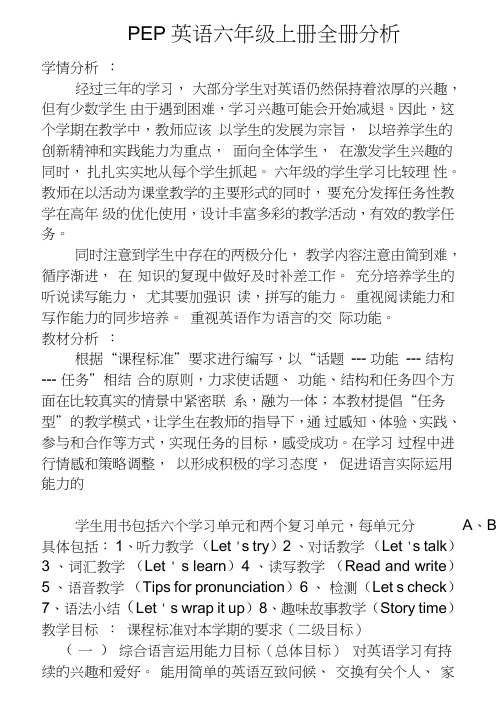
PEP 英语六年级上册全册分析学情分析:经过三年的学习,大部分学生对英语仍然保持着浓厚的兴趣,但有少数学生由于遇到困难,学习兴趣可能会开始减退。
因此,这个学期在教学中,教师应该以学生的发展为宗旨,以培养学生的创新精神和实践能力为重点,面向全体学生,在激发学生兴趣的同时,扎扎实实地从每个学生抓起。
六年级的学生学习比较理性。
教师在以活动为课堂教学的主要形式的同时,要充分发挥任务性教学在高年级的优化使用,设计丰富多彩的教学活动,有效的教学任务。
同时注意到学生中存在的两极分化,教学内容注意由简到难,循序渐进,在知识的复现中做好及时补差工作。
充分培养学生的听说读写能力,尤其要加强识读,拼写的能力。
重视阅读能力和写作能力的同步培养。
重视英语作为语言的交际功能。
教材分析:根据“课程标准”要求进行编写,以“话题--- 功能--- 结构--- 任务”相结合的原则,力求使话题、功能、结构和任务四个方面在比较真实的情景中紧密联系,融为一体;本教材提倡“任务型”的教学模式,让学生在教师的指导下,通过感知、体验、实践、参与和合作等方式,实现任务的目标,感受成功。
在学习过程中进行情感和策略调整,以形成积极的学习态度,促进语言实际运用能力的学生用书包括六个学习单元和两个复习单元,每单元分A、B 具体包括:1、听力教学(Let 's try)2 、对话教学(Let 's talk)3 、词汇教学(Let ' s learn)4 、读写教学(Read and write)5 、语音教学(Tips for pronunciation)6 、检测(Let s check)7、语法小结(Let ' s wrap it up)8、趣味故事教学(Story time)教学目标:课程标准对本学期的要求(二级目标)(一)综合语言运用能力目标(总体目标)对英语学习有持续的兴趣和爱好。
能用简单的英语互致问候、交换有关个人、家庭和朋友的简单信息。
2014新版pep六上英语第一二单元教案

教材分析Unit 1 How can I get there?一、教学内容1、本单元要求会听,说,认读的单词:Science, museum, post office, bookstore,cinema, hospital, crossing, turn, left,straight, right.2、本单元要求会听,说认读的句型:Where is the...? It’s near/next to/behind...? How can we get there? Turn left/right.... Then ....3、能够掌握朗读句子时的升降调。
二、教学要求1、知识与能力目标1)能够听、说、认读句型:Where is the...? It’s near/next to/behind... How can we get there? Turn left/right.... Then ....2)能够在情景中运用句型Where is the...? It’s near/next to/behind...询问回答位置。
并表述行走路线。
3)能够掌握朗读句子时的升降调4)能够听、说、认读单词:Science, museum, post office, bookstore,cinema, hospital, crossing, turn, left,straight, right.6)运用上述描述表达路线。
2、情感态度、文化意识、学习策略目标1)学习礼貌言行,知道遵守交通规则。
三、教学重点和难点重点:1、听懂、会说本单元的对话,并能对路线进行描述。
2、听、说、认读本单元单词。
3、能够掌握朗读句子时的升降调。
难点:难点单词的正确发音四、教学时间。
Pep小学英语六年级上册教案 全册

Unit 1 How can I get there?第一课时A Let’s learn,Make a map and talk一、教学目标:1能够听、说、读、写science museum, post office, bookstore, cinema, hospital.2能够听、说、认读短语:near 在……附近, next to 与……相邻3能够听、说、认读句型:Where is the cinema?It’s next to the bookstore. It’s near the park.并进行关键词的替换操练。
二、教学重、难点1、掌握Let's learn部分的四会单词、短语及句子。
2、准确书写四会单词和掌握单词museum的发音。
三、教学过程Step1.Preparation教师放三年级下册第六单元的歌曲“They Are in the Zoo.'’师生齐唱。
Step 2.Presentation1单词呈现(1)“请你猜猜”活动教师课前在黑板上画一个框,将hospital,post office,bookstore,cinema,science museum,park,library,school等单词卡片反面朝外贴在黑板上作为地图,每张卡片面都写着数字。
教师指着其中一张卡片说:“Now I am in No.l. Please{what place it is.Is it a zoo/school/park…?”教师要注意先出示两个学生的场所,第三次再让学生猜的时候,他们首先会考虑学过的词汇,这时再呈现新词cinema。
教师示范朗读,学生跟读。
教师带领学生拼读并cinema。
(2)继续做“请你猜猜”活动。
教师说:“No.3 is a cinema.We can see afilm’cinema.”接下来教师拿出一封信,说:“1 want to post the letter. Shall I go to the cinema? Where shall I go? Yes! Post office.”教师继续利用黑板上的卡片让学生猜:“Is it a post office?”并领读post office。
最新六年级上册英语教案-Unit2 B Let's talk人教版PEP(2014秋)
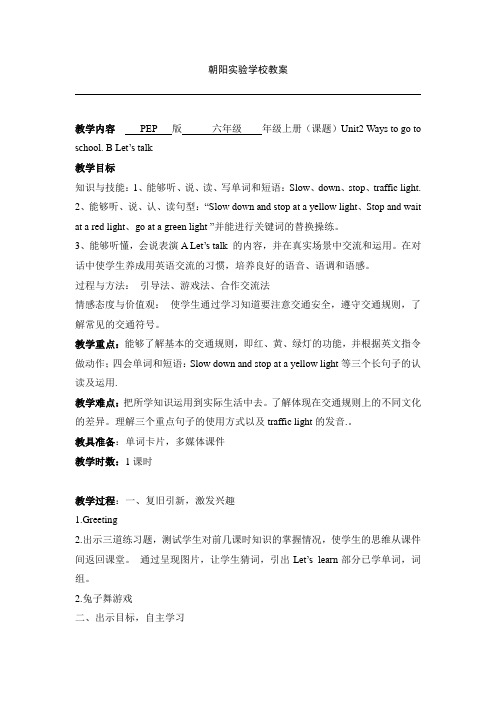
朝阳实验学校教案school. B Let’s talk教学目标知识与技能:1、能够听、说、读、写单词和短语:Slow、down、stop、traffic light.2、能够听、说、认、读句型:“Slow down and stop a t a yellow light、Stop and wait at a red light、go at a green light ”并能进行关键词的替换操练。
3、能够听懂,会说表演A Let’s talk 的内容,并在真实场景中交流和运用。
在对话中使学生养成用英语交流的习惯,培养良好的语音、语调和语感。
过程与方法:引导法、游戏法、合作交流法情感态度与价值观:使学生通过学习知道要注意交通安全,遵守交通规则,了解常见的交通符号。
教学重点:能够了解基本的交通规则,即红、黄、绿灯的功能,并根据英文指令做动作;四会单词和短语:Slow down and stop at a yellow light等三个长句子的认读及运用.教学难点:把所学知识运用到实际生活中去。
了解体现在交通规则上的不同文化的差异。
理解三个重点句子的使用方式以及traffic light的发音.。
教具准备:单词卡片,多媒体课件教学时数:1课时教学过程:一、复旧引新,激发兴趣1.Greeting2.出示三道练习题,测试学生对前几课时知识的掌握情况,使学生的思维从课件间返回课堂。
通过呈现图片,让学生猜词,引出Let’s learn部分已学单词,词组。
2.兔子舞游戏二、出示目标,自主学习教师在PPT上呈现本节课的学习目标,学生带着自学目标尝试翻译课文中的单词短语,并拼读。
三、创设情境,构建新知(1)老师请出若干名学生,让学生根据指令做动作,连续做错两次动作的学生被淘汰,如教师说red light,学生停着不动;说yellow light,学生做好走的准备;green light,学生往前走。
通过出示课文中的部分挂图让学生观察,感知预测文本内容。
2014PEP小学英语六年级上册教案新部编本
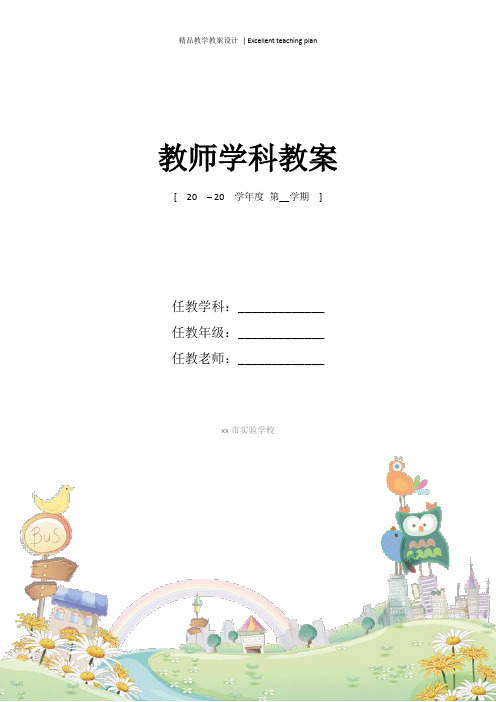
教师学科教案[ 20 – 20 学年度第__学期]任教学科:_____________任教年级:_____________任教老师:_____________xx市实验学校2014新版PEP小学英语六年级上册Unit 1 How can I get there?第一课时教学内容:Main scene Part A Let’s try & Let’s talk教学目标:1. 能够正确听说朗读Where is the science museum? It’s…How can I get there?等询问某个地方在哪里以及如何才能到达那里的相关问路与指路的交际用语。
2. 能够正确听说认读表示地点的名词和短短语,如:science museum、post office、museum shop、bookstore等,方位介词next to、near、behind等,以及动词短语turn right(left)、go straight。
重点难点:重点:学生能够表演Main scene和Let’s talk的交际内容,能够根据实际情况用英语问路和指路。
难点:用英语准确询问并回答地点方位,如“Where is the post office?It’s next to the museum.”等。
教学设计:Step1 Warming up1. Let’s look and say the names.(通过多媒体呈现一些公共地反的图片,如博物馆、邮局、学校、书店等,让学生说出来这些地点。
)2. Listen and chant老师自编chant,加入museum之类的地点词。
3.Listen and do 老师播放兔子舞的歌曲,让学生感受left 、right等词。
Step 2 Presentation1. Main scene的学习:(1)出示main scene中的教学图片,让学生观察Who are they?What are they talking about?(2)教师引导学生将讨论的结果展示交流,注意紧扣教学内容。
人教版六年级英语上册教案(完整)
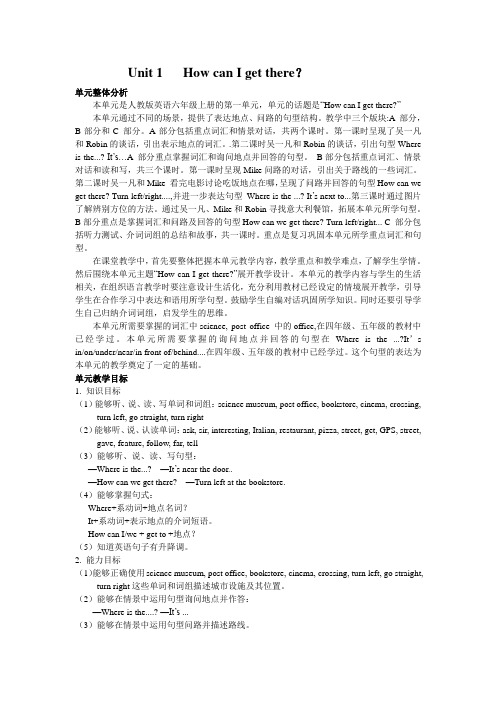
(1)How can I/we get to...?
例:我怎么能到电影院?
How can I get to the cinema?
(2)Whereis the ...?
例:图书馆在哪儿?
Excuse me, where is the library?
(3) Can you tell me the way to the...?
课时分析
本课时是人教版六年级上册第一单元第一课时。围绕Where is the...?这一话题展开,主要通过对话学习词汇science museum, post office, bookstore, cinema, hospital及句型Where isthe...? It’s next to...的表达。引导学生了解一些简单的构词规律,发音规律,培养学生学习英语的热情,树立学好英语的信心。第一课时是本单元的基础,学会了本课时所要掌握的知识,再学习其他课时就会很容易。本课时的重点是四会单词的掌握以及能够运用四会单词介绍场所的位置。
(3)能够听、说、读、写句型:
—Where is the...?—It’s near the door..
—Howcan we get there?—Turn left at the bookstore.
(4)能够掌握句式:
Where+系动词+地点名词?
It+系动词+表示地点的介词短语。
How can I/we + get to +地点?
Unit 1How can I get there?
单元整体分析
本单元是人教版英语六年级上册的第一单元,单元的话题是“How can I get there?”
人教PEP版-英语-六年级上册-Unit1 Period4-精品教案人教PEP(2014秋)
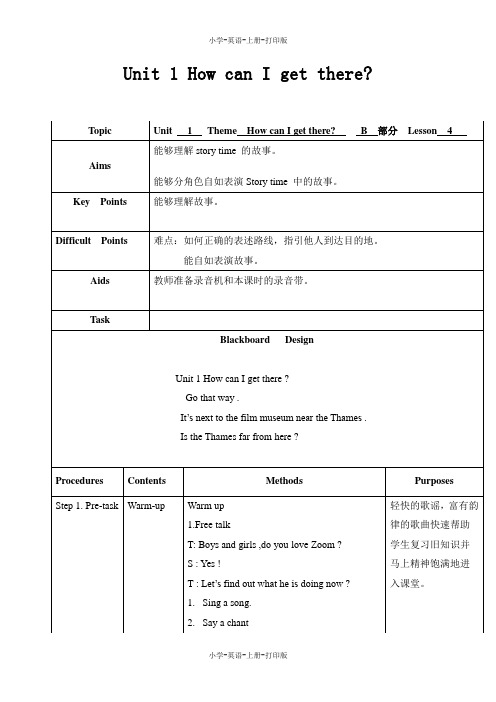
Topic
Unit1ThemeHow can I get there?B部分Lesson4
Aims
能够理解story time的故事。
能够分角色自如表演Story time中的故事。
Key Points
能够理解故事。
Difficult Points
Step 4 : consolidation and extension
1.讲story time部分的故事朗读给家长听。
2.优化设计练习。(分层)
轻快的歌谣,富有韵律的歌曲快速帮助学生复习旧知识并马上精神饱满地进入课堂。
文化渗透,让语言学习与文化感悟结合。
采用任务型教学途径,让学生在学中做,在做中学
S : Yes !
T : Let’s find out what he is doing now ?
1.Sing a song.
2.Say a chant
3.Let’s Check
(1)Listen and tick
(2)Check the answers.
Presentation
Story time
Is the Thames far from here ?
Procedures
Contents
Methods
Purposes
Step 1. Pre-task
Step2. While-task
Step 3. Post-task
Warm-up
Story time
Warm up
1.Free talk
T: Boys and girls ,do you love Zห้องสมุดไป่ตู้om ?
- 1、下载文档前请自行甄别文档内容的完整性,平台不提供额外的编辑、内容补充、找答案等附加服务。
- 2、"仅部分预览"的文档,不可在线预览部分如存在完整性等问题,可反馈申请退款(可完整预览的文档不适用该条件!)。
- 3、如文档侵犯您的权益,请联系客服反馈,我们会尽快为您处理(人工客服工作时间:9:00-18:30)。
Unit 1 How can I get there?第一课时一、教学内容:A Let’s learn / Make a map and talk二、教学目标与要求:1.能够听、说、读、写单词或短语:hospital,cinema,Post Office, bookstore2.能够听、说、认读短语science museum。
3.能够听、说、认读句型:“Where is the library? It'snear the post office.”并进行关键词的替换操练。
4.会唱歌曲《Where is the hospital?》5.引导学生在学习过程中注重合作学习,培养学生合作学习意识。
三、教学重难点分析1、掌握Let's learn部分的四会单词和短语。
2、准确书写四会单词和掌握三会单词museum的发音。
3. 掌握句型:“Where is the library? It's near thepost office.”进行关键词的替换操练。
四、教具:录音机、录音带。
五、教学过程:1. Warm-up(1) Greeting(2)师生对话,复习介词in,on, under, behind,in front of, near, next to.2.新课呈现(Presentation)Let's learn(1) listen and sayT: I want to post the letter. Where can I go? (post office) Oh, I feel bad, I need to see a doctor.Where can I go? (hospital)I’m ok now, I want to see a film, Where can I go? (cinema) I need to buy some books, where can I go? (bookstore)Q: Where is the post office? (It’s near the hospital.) E: We also can say “it’s next to the hospital.”Can you guess what meaning of “next to”?(It’s the same as near.)(2) Make a map and talkThere are other two buildings. Look at this one, this is a science museum. The other one is library.In the map, there are 2 blanks A and B. Now, pleaseguess ?where are they?Sence: I want to go to the library, but I don’t know how to get to the library? Can you help me?Q: Excuse me, How can I get to the library?A: …Q: Where is the library?A: …Listen to the tape, read after it.(4) Make dialogues(5) Next week, we will have a long holiday. I want to go to Beijing. I prepare a map. But it’s too small, who can help me write it on Bb?(6) Do the same with partners.六、HomeworkCopy the 4-skilled words, each 5 times.七、课后反思:第二课时一、教学内容:A Let’s try/ Let’s talk二、教学目标与要求:1.复习单词或短语:hospital,cinema,post office,bookstore, science museum2.能够听、说、读、写句型:“Where is the museum shop?It's near the door.”3. 能够听、说、认读单词:ask,sir,interesting和句子:Is there a...? I want to... What a great museum!三、教学重难点分析1、学习句型:“Where is the museum shop? It's near the door.”2、正确使用方位介词。
四、教具单词卡、录音机、录音带。
五、教学过程:1.Warm-upLet’s doGo to the bookstore.Buy some books.Go to the post office.Send a letter.Go to the hospital.See the doctor.Go to the cinema.See a film.Go to the museum.See some robots.2.Revision复习单词或短语:hospital,cinema,post office,bookstore,science museum.教师先出示单词卡片,抽读这五个单词,然后再出示图片,让学生看图说单词。
3.presentationLet’s try(1)打开课本读一读Let’s try中呈现的问题和选项。
(2)播放录音,学生听完后勾出正确的选项。
(3)全班校对答案。
Let’s talk(1)播放Let’s talk录音,学生带着问题听录音,where is the museum shop?where is the post office?听完录音后让学生回答这两个问题,教师板书:It’s near the door. It's next to the museum.教师讲解:“near”表示在附近,“next to”表示与……相邻,它的范围比near小。
最后让学生用“near”和“next to”来讲述学校周围的建筑物。
(2)讲解“A talking robot!What a great museum!”,(3)让学生说说这两个感叹句的意思。
(3)跟读、领读Let’s talk.(4)分角色朗读课文。
4.Consolidation and extension(1)分角色扮演Let’s talk的内容,三人一组表演对话,(2)然后请一些同学到台前表演。
教学A. Talk about the places in your city/town/village.活动方式:教师引导学生共同回忆学过的公共场所名称,并将其板书在黑板上,如:park,library,zoo,school,museum等,先与一名学生示范问答:T: Is there a zoo in our city?S:Yes, there is.T: Where is it?S: It’s near the park.然后学生两人一组进行问答练习。
5.Homework(1)听录音跟读对话。
(2)完成配套练习。
第三课时课时目标1.能听说,读,写单词和词组:crossing,turn left,go straight,turn right.2.能听说,读,写单词:Italian,restaurant.3.能听说,读,写句子:Where is the Italian restaurant?Turn right here?No,turnleft.并能在实际情景中正确使用。
教学重难点1.重点:能听说,读,写单词和词组: crossing,turn left,go straight,turn right.2.难点:go straight的发音和拼写。
教具安排1.配套的教学课件。
2.图片和单词卡片。
3.录音机和磁带。
教学过程一.热身(Warm-up)1.师生问候。
2.sing a song:Where is the hospital?二.复习(Revision)1.游戏:what’s missing?活动方式:全班先抽读单词卡片:science museum,post office,bookstore,cinema,hospital,然后教师藏起其中一张单词卡片,问学生:What’s missing?为最快说出答案的学生所在的组加分。
2.游戏:句子接龙活动方式:教师先说一个公共场所的名称,接着让一个学生在重复教师所说场所名称的基础上再加一个场所的名称。
以此类推,如果说不出行的场所,获场所的顺序有误的话则被判出局。
如:T:I can see a hospital.S1: I can see a hospital and a post office.S2: I can see a hospital ,a post office and a cinema.三、新课呈现(presentation)1. 教学词组:turn left turn right(1)学生排成一列纵队,后面的学生手搭在前面的学生的肩上,教师放“兔子舞”音乐,和学生一起跳“兔子舞”。
跳的时候教师要注意示范left和right,如左右脚、左右手的动作。
(2)跳完后教师再一次举起左右手和左右脚并重复单词right和 left,板书:right 和left,带读right 和left。
(3)活动:听听做做活动方式:教师发指令:show me your right/left hand/leg/ear/foot.全班同学根据指令动作,边做边说:My right/left hand/leg/ear/foot.然后改由一个学生发指令,其他同学边说边做动作。
(4)出示左转的图片说:turn left,补充板书成:turn right,让学生与教师一起边做左转的手势边说turn left。
同步骤教学turn right。
(5)队列训练活动方式:每组请上两位学生在讲台前一字排开,教师发出指令: turn right,turn left,则学生边右转、左转边重复:turn right, turn left。
说错或转错则被判出局,留下的学生为胜者。
接着可以改由学生发指令继续活动。
2.教学词组: go straight(1) 教师再黑板上用尺子画一条直线,指着直线说:This lineis straight.板书:straight,带读straight。
然后采用“大小声”的游戏操练单词:即教师大声说单词,学生则小声说。
